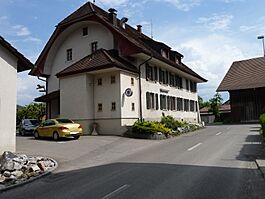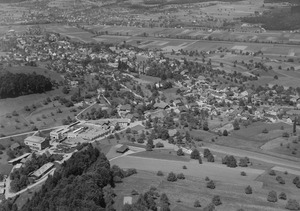Gontenschwil facts for kids
Quick facts for kids
Gontenschwil
|
||
|---|---|---|
 |
||
|
||
| Country | Switzerland | |
| Canton | Aargau | |
| District | Kulm | |
| Area | ||
| • Total | 9.74 km2 (3.76 sq mi) | |
| Elevation | 531 m (1,742 ft) | |
| Population
(Dec 2020 )
|
||
| • Total | 2,130 | |
| • Density | 218.7/km2 (566.4/sq mi) | |
| Postal code |
5728
|
|
| Surrounded by | Leimbach, Oberkulm, Pfeffikon (LU), Reinach, Rickenbach (LU), Schmiedrued, Zetzwil | |
Gontenschwil is a small town in Switzerland. It is a municipality in the Kulm district. This district is part of the canton of Aargau.
Contents
A Look at Gontenschwil's Past
Gontenschwil was first mentioned in history in 1173. Back then, it was called Gundoltswilre. Over the years, different groups owned parts of the village. These included monasteries and powerful families. For example, the Knights of Malta owned some land in 1274.
The Habsburgs also had rights over the village. They ruled through their local helpers, the Counts of Reinach. By this time, any old castle in the area was no longer mentioned. Local wealthy citizens handled smaller legal matters. After Bern took over Aargau in 1415, Gontenschwil became its own court area. This was within the larger Lenzburg district.
The Village Church and Religion
The church in Gontenschwil was first mentioned in 1340. It was originally a smaller church connected to Pfeffikon's main church. After some disagreements between Bern and Lucerne, Gontenschwil became its own independent church. This happened during the Protestant Reformation. The church building you see today was built in 1622.
How Gontenschwil Grew Economically
Besides farming, Gontenschwil also had many small businesses. In 1640, a special mineral water spring was found. This spring was popular from the 1800s until World War I. It was used to bottle water until 1990.
In the 1700s and 1800s, making cotton thread and fabric was very important. These big industries made Gontenschwil the second largest town in the Kulm district. When the cotton industry faced problems, tobacco processing took its place. In 1900, an aluminum factory started in an old water mill. This factory grew into the Menziken aluminum factory. Other local factories now make washing machines and plastic products.
Where is Gontenschwil Located?
Gontenschwil covers an area of about 9.74 square kilometers (3.76 sq mi). A large part of this land, about 60.3%, is used for farming. Forests cover about 26.0% of the area. Buildings and roads make up about 13.6% of the land. A small part, 0.5%, is rivers or lakes.
The town is in the Kulm district. It sits behind a natural ridge left by a glacier long ago. Gontenschwil includes the main village and two smaller areas. These smaller areas are called Geisshof and Hasel. Geisshof joined Gontenschwil from Reinach in 1901.
Gontenschwil's Coat of Arms
The town's coat of arms has a special design. It shows a green pine tree. This tree grows from a green base. Above the tree, there are two red hearts. All of this is on a silver background.
Who Lives in Gontenschwil?
As of 2009, Gontenschwil had a population of 2,101 people. About 15.7% of the people living there are from other countries. Over the last ten years, the population has stayed mostly the same. Most people in Gontenschwil speak German. Some also speak Serbo-Croatian or Albanian.
Age Groups in Gontenschwil
In 2008, about 9.3% of the population were children aged 0-9 years. Teenagers aged 10-19 made up 11.8% of the population. Adults aged 20-59 made up about 55.1% of the population. Older adults, aged 60 and above, made up about 23.8% of the population.
Education in Gontenschwil
People in Switzerland are generally well-educated. In Gontenschwil, about 70.8% of adults have finished higher education. This means they went to a university or a special college. In the 2008/2009 school year, 152 students attended primary school. Another 98 students attended secondary school in the town.
Historical Population Growth
Here's how the population of Gontenschwil has changed over time:
- 1653: 545 people
- 1850: 2,297 people
- 1900: 1,646 people
- 1950: 2,102 people
- 2000: 2,055 people
Important Buildings and Sites
The Fischerhübel house is a very important building. It is listed as a Swiss heritage site of national significance. This means it is a special place that helps tell the story of Switzerland.
Working in Gontenschwil
In 2007, Gontenschwil had a low unemployment rate of 1.59%. This means most people who wanted to work had jobs. Many people who live in Gontenschwil work outside the town. However, many people also travel into Gontenschwil for work. In 2000, there were 771 jobs available in the town. Most people used a private car to get to work. About 7.8% used public transportation.
Religious Beliefs
Based on a 2000 survey, most people in Gontenschwil are part of the Swiss Reformed Church. About 65.8% of the population belonged to this church. Another 15.9% were Roman Catholic.
See also
 In Spanish: Gontenschwil para niños
In Spanish: Gontenschwil para niños






